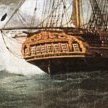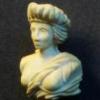-
Posts
6,360 -
Joined
-
Last visited
Reputation Activity
-
 wefalck reacted to LJP in J H Crawford by LJP (Lawrence Paplham) - Scale 1:64 - an 1894 to 1898 Wisconsin sternwheeler
wefalck reacted to LJP in J H Crawford by LJP (Lawrence Paplham) - Scale 1:64 - an 1894 to 1898 Wisconsin sternwheeler
Family duties took longer than expected.
The false stern panel also took longer than expected. To get the false stern panel to fit within the sternwheel braces, I needed to deconstruct part of that assembly. I prepared a cardboard mockup of what the panel would look like and then built the panel.
I used dry erase lettering for the boat name and home port.
The interior panel was white for the boiler deck although the panel is only currently at partial height. The main deck interior panel is painted yellow at the top and with a grey bottom. This is the colour scheme that I noted at the Dawson City boat graveyard but also what was used on S S Moyie.
My intent is to leave the main deck panels off on the port boiler and engine rooms so you can see the interior boat detail. I am not certain if I will also leave the port panels off on the boiler deck to allow visual access to the saloons and staterooms. I have lots of time before that needs to be decided.
Next step is to build the crew quarters in the engine room.
-
 wefalck got a reaction from FriedClams in Lancha Chilota by JacquesCousteau – Scale 1:32 – Chilean Coasting Sloop
wefalck got a reaction from FriedClams in Lancha Chilota by JacquesCousteau – Scale 1:32 – Chilean Coasting Sloop
I had discovered decades ago that making half-hitches eases the seizing of blocks etc. a lot and keeps the rounds in place. The only issue is that one can see this on one side, so strategic placing of the 'hitch' to become mostly not visible is a good idea.
If you are averse to using an organic solvent-based varnish (e.g. diluted clear nail varnish) for securing rigging, you may want to try the cement they use in nail-studios to stick artificial nails to ladies' real nails. I recently discovered that this is a mixture of CA and metacrylic monomers: it sticks quite fast, but you have several minutes to adjust things before it fully cures. It is not as 'nasty' as pure CA and forms strong bonds. It should be readily available in your part of the world.
-
 wefalck got a reaction from FriedClams in Lula by Keith Black - FINISHED - 1:120 Scale - 1870s Sternwheeler Supply Boat for Floating Pile Driver
wefalck got a reaction from FriedClams in Lula by Keith Black - FINISHED - 1:120 Scale - 1870s Sternwheeler Supply Boat for Floating Pile Driver
So it kind of operates like the knee-levers on electrical sewing machines? Interesting mechanism.
She now really looks like a hard-working vessel 👍🏻 I like these unsual workboats.
-
 wefalck got a reaction from KeithAug in Santos Dumont No. 18 Hydroplane 1907 by Greg Davis - FINISHED - Scale 1:16
wefalck got a reaction from KeithAug in Santos Dumont No. 18 Hydroplane 1907 by Greg Davis - FINISHED - Scale 1:16
Doesn't look too bad at all, but seems to be a quite complex process. What about cored solder of an appropriate diameter? It bends easily without tools (so as not to leave marks) and can be drilled out at the ends as needed. It would also be easily painted black/rust.
-
 wefalck got a reaction from Marcus.K. in Pomeranian Rahschlup 1846 by wefalck – 1/160 scale – single-masted Baltic trading vessel
wefalck got a reaction from Marcus.K. in Pomeranian Rahschlup 1846 by wefalck – 1/160 scale – single-masted Baltic trading vessel
Thanks to all for your continued encouragement ! Slow progress due to business travel-related absence from the workshop ...
*************
Planking the bulwarks
The planking of the bulwarks follows the same procedure as that for the hull, but had to be handled much more careful, as the inside will be visible and there will by no adjustments possible by sanding or scraping. The main reason for the latter is, that the planks are of scale thickness (0.25 mm) and profiled.
Section through a bulwark drawn by Friis-Pedersen (1980).
As can be seen from the two images above and below, it was not uncommon to give the edges of the planks a decorative profile by using an appropriate profile plane.
Bulwark of a Swedish jagt, photographed in November 2023 in Stockholm
I had been exploring various ideas for creating these profiles on tiny 1 mm x 0.25 mm styrene ‘planks’ uniformly and consistently close to the edges. In the end I decided on a simple and rather makeshift solution: a steel ruler was taped to a small cutting-mat to serve as guide for the very flexible strips. The chosen tool is an old-style ruling pen, of which I have several knocking about in my drawer of draughting utensils. This was set so that it creates a groove close to the opposite edge, when run along the edge of the strip. This works only for strips of uniform width.
It was important to prevent the styrene strips from softening too much during gluing, therefore only tiny drops of liquid styrene cement were applied to each stanchion.
Somehow the alignment of the bulkheads was not as perfect as I was hoping for, resulting in some bulges. I hope I will be able to correct/hide this somehow.
Another problem is that the styrene strips of scale thickness are rather floppy, so that edge-alignment is rather difficult. I hope that I can also sort this out.
Once the planks were on, I installed the hawse-timbers between the stem and the cant-frames in the bow.
Next on will be the rails.
To be continued …
-
 wefalck reacted to Keith Black in Lula by Keith Black - FINISHED - 1:120 Scale - 1870s Sternwheeler Supply Boat for Floating Pile Driver
wefalck reacted to Keith Black in Lula by Keith Black - FINISHED - 1:120 Scale - 1870s Sternwheeler Supply Boat for Floating Pile Driver
Thank you, Eric
Thank you, Eberhard. I used the photo below as inspiration for Lula's pilothouse interior and engine controls. I scaled the controls to match the height of the pilot to be added later. A US penny looks huge when placed on the floor of the PH. I'll make sure I get the photo taken and posted next time.
And that's the last photo I will use to complete Lula with the exception of the original historical photo of Lula. No more boilers, steam engines, derrick cranes, or pilothouses, just little Lula the car ferry. I need to make a chart table and chair (we'll see how that goes) and once those are done all remaining work is on the exterior.
I don't know why but it seems like I've been working on Lula for a very long time when in actuality i'm barely into my fifth month of actual fabrication. I find myself slowing down and reminiscing as much as I work as the end of my intimacy with Lula draws to a close.
-
 wefalck got a reaction from Glen McGuire in Lula by Keith Black - FINISHED - 1:120 Scale - 1870s Sternwheeler Supply Boat for Floating Pile Driver
wefalck got a reaction from Glen McGuire in Lula by Keith Black - FINISHED - 1:120 Scale - 1870s Sternwheeler Supply Boat for Floating Pile Driver
So it kind of operates like the knee-levers on electrical sewing machines? Interesting mechanism.
She now really looks like a hard-working vessel 👍🏻 I like these unsual workboats.
-
 wefalck got a reaction from KeithAug in Lula by Keith Black - FINISHED - 1:120 Scale - 1870s Sternwheeler Supply Boat for Floating Pile Driver
wefalck got a reaction from KeithAug in Lula by Keith Black - FINISHED - 1:120 Scale - 1870s Sternwheeler Supply Boat for Floating Pile Driver
So it kind of operates like the knee-levers on electrical sewing machines? Interesting mechanism.
She now really looks like a hard-working vessel 👍🏻 I like these unsual workboats.
-
 wefalck reacted to Keith Black in Lula by Keith Black - FINISHED - 1:120 Scale - 1870s Sternwheeler Supply Boat for Floating Pile Driver
wefalck reacted to Keith Black in Lula by Keith Black - FINISHED - 1:120 Scale - 1870s Sternwheeler Supply Boat for Floating Pile Driver
Thank you to all for your comments and likes.
Lula as she now sits, everything shown is glued into place.
I added a tallow barrel against the forward coal bin wall. The pilothouse stove stack will be shortened once the pilot house roof is attached.
The engine controls have been added. Center and bellow the ships wheel is a foot plunger that activates the steam whistle.
To either side of the steam whistle foot control are foot levers and next to the foot levers are the throttle control levers. When in the foot levers are in the up position both throttle control levers are connected to one another and operate in tandem. When a foot lever is stepped on and in the down position that particular throttle control lever is disengaged. If both foot levers are down then both throttle control levers are disengaged.
To either side of the throttle control levers are the engine forward/reverse levers. When the levers are parallel with the ships wheel the engines are in the stop position.
A little bit better view of port side foot lever.
Thank you to everyone for your support by following along and being part of the journey.
Keith
-
 wefalck got a reaction from archjofo in Pomeranian Rahschlup 1846 by wefalck – 1/160 scale – single-masted Baltic trading vessel
wefalck got a reaction from archjofo in Pomeranian Rahschlup 1846 by wefalck – 1/160 scale – single-masted Baltic trading vessel
Thanks to all for your continued encouragement ! Slow progress due to business travel-related absence from the workshop ...
*************
Planking the bulwarks
The planking of the bulwarks follows the same procedure as that for the hull, but had to be handled much more careful, as the inside will be visible and there will by no adjustments possible by sanding or scraping. The main reason for the latter is, that the planks are of scale thickness (0.25 mm) and profiled.
Section through a bulwark drawn by Friis-Pedersen (1980).
As can be seen from the two images above and below, it was not uncommon to give the edges of the planks a decorative profile by using an appropriate profile plane.
Bulwark of a Swedish jagt, photographed in November 2023 in Stockholm
I had been exploring various ideas for creating these profiles on tiny 1 mm x 0.25 mm styrene ‘planks’ uniformly and consistently close to the edges. In the end I decided on a simple and rather makeshift solution: a steel ruler was taped to a small cutting-mat to serve as guide for the very flexible strips. The chosen tool is an old-style ruling pen, of which I have several knocking about in my drawer of draughting utensils. This was set so that it creates a groove close to the opposite edge, when run along the edge of the strip. This works only for strips of uniform width.
It was important to prevent the styrene strips from softening too much during gluing, therefore only tiny drops of liquid styrene cement were applied to each stanchion.
Somehow the alignment of the bulkheads was not as perfect as I was hoping for, resulting in some bulges. I hope I will be able to correct/hide this somehow.
Another problem is that the styrene strips of scale thickness are rather floppy, so that edge-alignment is rather difficult. I hope that I can also sort this out.
Once the planks were on, I installed the hawse-timbers between the stem and the cant-frames in the bow.
Next on will be the rails.
To be continued …
-
 wefalck got a reaction from Harvey Golden in Pomeranian Rahschlup 1846 by wefalck – 1/160 scale – single-masted Baltic trading vessel
wefalck got a reaction from Harvey Golden in Pomeranian Rahschlup 1846 by wefalck – 1/160 scale – single-masted Baltic trading vessel
Thanks to all for your continued encouragement ! Slow progress due to business travel-related absence from the workshop ...
*************
Planking the bulwarks
The planking of the bulwarks follows the same procedure as that for the hull, but had to be handled much more careful, as the inside will be visible and there will by no adjustments possible by sanding or scraping. The main reason for the latter is, that the planks are of scale thickness (0.25 mm) and profiled.
Section through a bulwark drawn by Friis-Pedersen (1980).
As can be seen from the two images above and below, it was not uncommon to give the edges of the planks a decorative profile by using an appropriate profile plane.
Bulwark of a Swedish jagt, photographed in November 2023 in Stockholm
I had been exploring various ideas for creating these profiles on tiny 1 mm x 0.25 mm styrene ‘planks’ uniformly and consistently close to the edges. In the end I decided on a simple and rather makeshift solution: a steel ruler was taped to a small cutting-mat to serve as guide for the very flexible strips. The chosen tool is an old-style ruling pen, of which I have several knocking about in my drawer of draughting utensils. This was set so that it creates a groove close to the opposite edge, when run along the edge of the strip. This works only for strips of uniform width.
It was important to prevent the styrene strips from softening too much during gluing, therefore only tiny drops of liquid styrene cement were applied to each stanchion.
Somehow the alignment of the bulkheads was not as perfect as I was hoping for, resulting in some bulges. I hope I will be able to correct/hide this somehow.
Another problem is that the styrene strips of scale thickness are rather floppy, so that edge-alignment is rather difficult. I hope that I can also sort this out.
Once the planks were on, I installed the hawse-timbers between the stem and the cant-frames in the bow.
Next on will be the rails.
To be continued …
-
 wefalck got a reaction from shipman in Pomeranian Rahschlup 1846 by wefalck – 1/160 scale – single-masted Baltic trading vessel
wefalck got a reaction from shipman in Pomeranian Rahschlup 1846 by wefalck – 1/160 scale – single-masted Baltic trading vessel
Thanks to all for your continued encouragement ! Slow progress due to business travel-related absence from the workshop ...
*************
Planking the bulwarks
The planking of the bulwarks follows the same procedure as that for the hull, but had to be handled much more careful, as the inside will be visible and there will by no adjustments possible by sanding or scraping. The main reason for the latter is, that the planks are of scale thickness (0.25 mm) and profiled.
Section through a bulwark drawn by Friis-Pedersen (1980).
As can be seen from the two images above and below, it was not uncommon to give the edges of the planks a decorative profile by using an appropriate profile plane.
Bulwark of a Swedish jagt, photographed in November 2023 in Stockholm
I had been exploring various ideas for creating these profiles on tiny 1 mm x 0.25 mm styrene ‘planks’ uniformly and consistently close to the edges. In the end I decided on a simple and rather makeshift solution: a steel ruler was taped to a small cutting-mat to serve as guide for the very flexible strips. The chosen tool is an old-style ruling pen, of which I have several knocking about in my drawer of draughting utensils. This was set so that it creates a groove close to the opposite edge, when run along the edge of the strip. This works only for strips of uniform width.
It was important to prevent the styrene strips from softening too much during gluing, therefore only tiny drops of liquid styrene cement were applied to each stanchion.
Somehow the alignment of the bulkheads was not as perfect as I was hoping for, resulting in some bulges. I hope I will be able to correct/hide this somehow.
Another problem is that the styrene strips of scale thickness are rather floppy, so that edge-alignment is rather difficult. I hope that I can also sort this out.
Once the planks were on, I installed the hawse-timbers between the stem and the cant-frames in the bow.
Next on will be the rails.
To be continued …
-
 wefalck got a reaction from FriedClams in Pomeranian Rahschlup 1846 by wefalck – 1/160 scale – single-masted Baltic trading vessel
wefalck got a reaction from FriedClams in Pomeranian Rahschlup 1846 by wefalck – 1/160 scale – single-masted Baltic trading vessel
Thanks to all for your continued encouragement ! Slow progress due to business travel-related absence from the workshop ...
*************
Planking the bulwarks
The planking of the bulwarks follows the same procedure as that for the hull, but had to be handled much more careful, as the inside will be visible and there will by no adjustments possible by sanding or scraping. The main reason for the latter is, that the planks are of scale thickness (0.25 mm) and profiled.
Section through a bulwark drawn by Friis-Pedersen (1980).
As can be seen from the two images above and below, it was not uncommon to give the edges of the planks a decorative profile by using an appropriate profile plane.
Bulwark of a Swedish jagt, photographed in November 2023 in Stockholm
I had been exploring various ideas for creating these profiles on tiny 1 mm x 0.25 mm styrene ‘planks’ uniformly and consistently close to the edges. In the end I decided on a simple and rather makeshift solution: a steel ruler was taped to a small cutting-mat to serve as guide for the very flexible strips. The chosen tool is an old-style ruling pen, of which I have several knocking about in my drawer of draughting utensils. This was set so that it creates a groove close to the opposite edge, when run along the edge of the strip. This works only for strips of uniform width.
It was important to prevent the styrene strips from softening too much during gluing, therefore only tiny drops of liquid styrene cement were applied to each stanchion.
Somehow the alignment of the bulkheads was not as perfect as I was hoping for, resulting in some bulges. I hope I will be able to correct/hide this somehow.
Another problem is that the styrene strips of scale thickness are rather floppy, so that edge-alignment is rather difficult. I hope that I can also sort this out.
Once the planks were on, I installed the hawse-timbers between the stem and the cant-frames in the bow.
Next on will be the rails.
To be continued …
-
 wefalck got a reaction from thibaultron in Fractal vise on kickstarter
wefalck got a reaction from thibaultron in Fractal vise on kickstarter
Somewhere in the deep space of YouTube I saw a video on building one. I remember another video on restoring one, where one can see the construction. Sorry no links. In any case, it's a quite evolved piece of equipment.
In case this is too expensive or a too daunting task, there are other solutions for holding irregular objects. In the old days the manufacturers of water- or steam-armatures used two-jaw chucks with removable top-jaws that could be milled/turned to fit the object. A low-cost option would be a pot-chuck filled with some heat-softening plastic (hot glue may do), but it only works with metal objects, not wood.
-
 wefalck got a reaction from Rudolf in Pomeranian Rahschlup 1846 by wefalck – 1/160 scale – single-masted Baltic trading vessel
wefalck got a reaction from Rudolf in Pomeranian Rahschlup 1846 by wefalck – 1/160 scale – single-masted Baltic trading vessel
Thanks to all for your continued encouragement ! Slow progress due to business travel-related absence from the workshop ...
*************
Planking the bulwarks
The planking of the bulwarks follows the same procedure as that for the hull, but had to be handled much more careful, as the inside will be visible and there will by no adjustments possible by sanding or scraping. The main reason for the latter is, that the planks are of scale thickness (0.25 mm) and profiled.
Section through a bulwark drawn by Friis-Pedersen (1980).
As can be seen from the two images above and below, it was not uncommon to give the edges of the planks a decorative profile by using an appropriate profile plane.
Bulwark of a Swedish jagt, photographed in November 2023 in Stockholm
I had been exploring various ideas for creating these profiles on tiny 1 mm x 0.25 mm styrene ‘planks’ uniformly and consistently close to the edges. In the end I decided on a simple and rather makeshift solution: a steel ruler was taped to a small cutting-mat to serve as guide for the very flexible strips. The chosen tool is an old-style ruling pen, of which I have several knocking about in my drawer of draughting utensils. This was set so that it creates a groove close to the opposite edge, when run along the edge of the strip. This works only for strips of uniform width.
It was important to prevent the styrene strips from softening too much during gluing, therefore only tiny drops of liquid styrene cement were applied to each stanchion.
Somehow the alignment of the bulkheads was not as perfect as I was hoping for, resulting in some bulges. I hope I will be able to correct/hide this somehow.
Another problem is that the styrene strips of scale thickness are rather floppy, so that edge-alignment is rather difficult. I hope that I can also sort this out.
Once the planks were on, I installed the hawse-timbers between the stem and the cant-frames in the bow.
Next on will be the rails.
To be continued …
-
 wefalck reacted to Jim Lad in Herzogin Cecilie 1902 by Jim Lad - Four Masted Barque
wefalck reacted to Jim Lad in Herzogin Cecilie 1902 by Jim Lad - Four Masted Barque
Thank you all for your very kind comments.
Wefalck - the model had the strange legal status of being owned by the museum but not being part of the museum's collection.
John
-
 wefalck got a reaction from mtaylor in Ancient Mediterranean Ships, Il Trabaccolo
wefalck got a reaction from mtaylor in Ancient Mediterranean Ships, Il Trabaccolo
Yep, have all three, but not the 'Kleber'.
The Museo Storico Navale in Venice has a rich collection of
Boat models: https://www.maritima-et-mechanika.org/maritime/venezia/museonavalevenezia-2.html
and real boats: https://www.maritima-et-mechanika.org/maritime/venezia/museonavalevenezia-3.html
from the Venetian lagoon and surrounding waters.
-
 wefalck got a reaction from mtaylor in Ancient Mediterranean Ships, Il Trabaccolo
wefalck got a reaction from mtaylor in Ancient Mediterranean Ships, Il Trabaccolo
The second link points to the Web-site of Gilberto Penzo, perhaps the authority on Venetian boats (and a nice guy), where you can buy his drawings and books. A few years ago he published a comprehensive book on the trabaccolo:
PENZO, G. (2020): Il Trabaccolo.- 230 p., Sottomarina (Ve) (Il Leggio Libreria Editrice).
-
 wefalck got a reaction from Harvey Golden in Ancient Mediterranean Ships, Il Trabaccolo
wefalck got a reaction from Harvey Golden in Ancient Mediterranean Ships, Il Trabaccolo
The second link points to the Web-site of Gilberto Penzo, perhaps the authority on Venetian boats (and a nice guy), where you can buy his drawings and books. A few years ago he published a comprehensive book on the trabaccolo:
PENZO, G. (2020): Il Trabaccolo.- 230 p., Sottomarina (Ve) (Il Leggio Libreria Editrice).
-

-
 wefalck got a reaction from Bryan Woods in Lancha Chilota by JacquesCousteau – Scale 1:32 – Chilean Coasting Sloop
wefalck got a reaction from Bryan Woods in Lancha Chilota by JacquesCousteau – Scale 1:32 – Chilean Coasting Sloop
I had discovered decades ago that making half-hitches eases the seizing of blocks etc. a lot and keeps the rounds in place. The only issue is that one can see this on one side, so strategic placing of the 'hitch' to become mostly not visible is a good idea.
If you are averse to using an organic solvent-based varnish (e.g. diluted clear nail varnish) for securing rigging, you may want to try the cement they use in nail-studios to stick artificial nails to ladies' real nails. I recently discovered that this is a mixture of CA and metacrylic monomers: it sticks quite fast, but you have several minutes to adjust things before it fully cures. It is not as 'nasty' as pure CA and forms strong bonds. It should be readily available in your part of the world.
-
 wefalck got a reaction from Glen McGuire in Lancha Chilota by JacquesCousteau – Scale 1:32 – Chilean Coasting Sloop
wefalck got a reaction from Glen McGuire in Lancha Chilota by JacquesCousteau – Scale 1:32 – Chilean Coasting Sloop
I had discovered decades ago that making half-hitches eases the seizing of blocks etc. a lot and keeps the rounds in place. The only issue is that one can see this on one side, so strategic placing of the 'hitch' to become mostly not visible is a good idea.
If you are averse to using an organic solvent-based varnish (e.g. diluted clear nail varnish) for securing rigging, you may want to try the cement they use in nail-studios to stick artificial nails to ladies' real nails. I recently discovered that this is a mixture of CA and metacrylic monomers: it sticks quite fast, but you have several minutes to adjust things before it fully cures. It is not as 'nasty' as pure CA and forms strong bonds. It should be readily available in your part of the world.
-
 wefalck got a reaction from Paul Le Wol in Lancha Chilota by JacquesCousteau – Scale 1:32 – Chilean Coasting Sloop
wefalck got a reaction from Paul Le Wol in Lancha Chilota by JacquesCousteau – Scale 1:32 – Chilean Coasting Sloop
I had discovered decades ago that making half-hitches eases the seizing of blocks etc. a lot and keeps the rounds in place. The only issue is that one can see this on one side, so strategic placing of the 'hitch' to become mostly not visible is a good idea.
If you are averse to using an organic solvent-based varnish (e.g. diluted clear nail varnish) for securing rigging, you may want to try the cement they use in nail-studios to stick artificial nails to ladies' real nails. I recently discovered that this is a mixture of CA and metacrylic monomers: it sticks quite fast, but you have several minutes to adjust things before it fully cures. It is not as 'nasty' as pure CA and forms strong bonds. It should be readily available in your part of the world.
-
 wefalck got a reaction from Keith Black in Lancha Chilota by JacquesCousteau – Scale 1:32 – Chilean Coasting Sloop
wefalck got a reaction from Keith Black in Lancha Chilota by JacquesCousteau – Scale 1:32 – Chilean Coasting Sloop
I had discovered decades ago that making half-hitches eases the seizing of blocks etc. a lot and keeps the rounds in place. The only issue is that one can see this on one side, so strategic placing of the 'hitch' to become mostly not visible is a good idea.
If you are averse to using an organic solvent-based varnish (e.g. diluted clear nail varnish) for securing rigging, you may want to try the cement they use in nail-studios to stick artificial nails to ladies' real nails. I recently discovered that this is a mixture of CA and metacrylic monomers: it sticks quite fast, but you have several minutes to adjust things before it fully cures. It is not as 'nasty' as pure CA and forms strong bonds. It should be readily available in your part of the world.
-
 wefalck reacted to JacquesCousteau in Lancha Chilota by JacquesCousteau – Scale 1:32 – Chilean Coasting Sloop
wefalck reacted to JacquesCousteau in Lancha Chilota by JacquesCousteau – Scale 1:32 – Chilean Coasting Sloop
Thanks Paul! Unfortunately I don't have annealed steel wire, the 24 gauge wire I have has a black plastic coating. I need to pick up some annealed wire soon, it would be a lot stronger and wouldn't require painting.
Thanks John!
I've now primed the metal parts that I've made so far, after first bending the chainplates into shape. This proved a bit frustrating, as I first tried sticking the hooks and thimbles (the latter of which will go on the ends of the shrouds and forestay) onto a bit of double-sided tape for priming. I didn't realize just how sticky our double-sided tape was, though, and it left a ton of residue. After soaking in alcohol overnight, it still took quite a bit of work to scrape it all off. I ended up instead placing the small parts, like the larger parts, on a loop of 28-gauge wire for priming instead.
I also finally added the cleats to the hull, although I still need to add a couple eyebolts with rings and a pair of the blocky double-cleats (not sure if there's an actual term for them) as well to finish up the deck furnishings.












